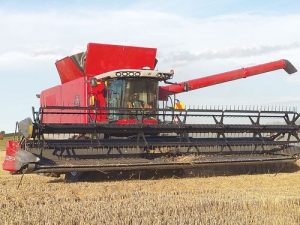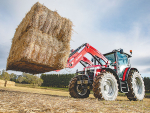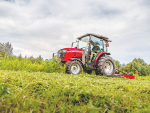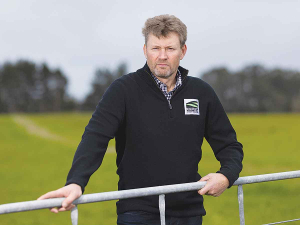It's safe to say that sales of combine harvesters in Southland are relatively few, so it’s interesting to hear of a new Massey Ferguson hitting the paddocks in February and making a big impact during the recent harvest for owners Mark and Sonia Dillon, Riversdale.
The Dillons purchase of the MF 9560 has seen a move up from an elderly MF865 and brother James’s equally elderly MF 750 to help complete the harvest.
With the home cropping farm and a contracting business, the machine did a mixed workload of barley, wheat and oats – amounting to around 600ha and dealing with the vagaries of Southland weather.
The heart of the machine is a 3.5m rotor mounted longitudinally in the chassis where it separates the grain from the straw with helical paddles, through a 12 section spring-loaded concave, to reduce chance of blockages. The rotor is fed by a feed drum accelerator that splits the crop flow into three streams to ensure the rotor is filled to capacity and the load is balanced. Once separated, the grain passes to a 6.1m2 cleaning area with a dual outlet fan.
Powers comes from the latest Agco Power/Sisu engine with a capacity of 9.8L and an output of around 460hp that boosts to 502hp for unloading on the move. The driveline consists of a four speed constant mesh unit coupled to a two stage hydrostatic ground drive unit, so effectively the operator has a choice of eight speeds to suit different field conditions, but more importantly the ability to shift from high to low in difficult conditions.
Grain goes into a 12,300L/9.5 tonne holding tank that unloads at 158L/sec.
Dillon says they were impressed with the machine’s output in the season just gone: it surpassed that of the two older machines by a long way.
“In one afternoon we cleared 30ha and 350 tonnes. In wheats we saw some big crops which were laid and the machine handled them well even though some samples were about 23% moisture. In barley we also saw some crops at 9-10t/ha that we thrashed with a rotor speed of 480rpm, but it still was gentle on the straw required for baling.”
Dillon says one big change was the move from a 16 foot header front to a 30 foot unit on the new machine, causing some trepidation about the undulating Southland terrain. This proved to be unfounded and was handled easily by the machine’s flex-front header.
“Harvest was a breeze and the impression of the machine is that of a rugged build, plenty of power, ease of maintenance with only nine belts and three chains on the whole machine.
“And it has a large comfortable cab, with fingertip controls for all functions and monitoring done through one touch screen that also incorporated the guidance system.”
www.masseyferguson.com.au



















